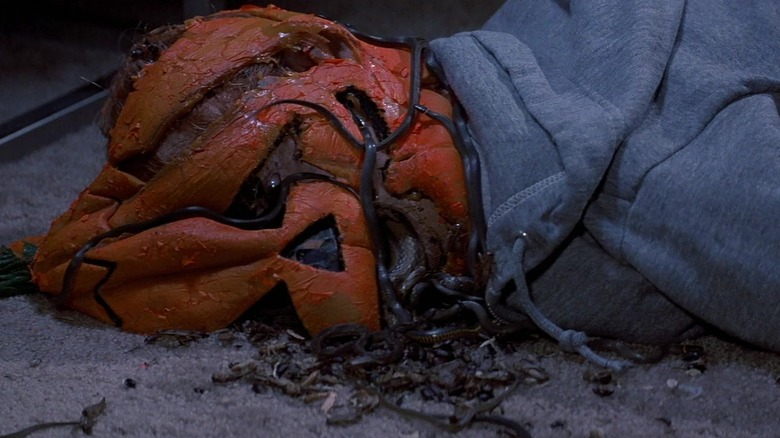Why John Carpenter Tried To Remove Michael Myers From The Halloween Franchise
As many horror fans might be able to tell you, no one was terribly excited to make "Halloween II." John Carpenter's 1978 "Halloween" was a runaway success, making $70 million on a minuscule $300,000 budget, so it seemed inevitable that a sequel should be made. The problem was, writers Carpenter and Debra Hill didn't have many ideas for one. "Halloween" was so efficient and trim, there wasn't a lot of extra story to be told. Michael Myers, the masked killer, didn't speak, and was constantly described as a bleak, mindless source of evil and death. He was so evil, his own psychiatrist shot him six times. Michael was semi-supernatural, and didn't lend himself well to mythology.
Carpenter famously declined to direct "Halloween II," passing on duties to Rick Rosenthal. He and Hill still wrote the screenplay, but one can see Carpenter trying to step back from making "Halloween" a franchise. In "Halloween II," it was revealed that Michael Myers had been stalking Laurie Strode (Jamie Lee Curtis) because she was secretly his little sister. Carpenter has repeated multiple times in interviews that he only included the familial twist because there was nothing to explore after "Halloween" ended. At the end of "Halloween II," Michael Myers had his eyeballs shot out, and then died in an explosion. This was meant to be the end of the end for Michael.
1982's "Halloween III: Season of the Witch" infamously didn't feature Michael Myers, Laurie Strode, or any slasher elements. It was a weird standalone project. Carpenter went on record back in 1996, in Vol. 3, issue #2 of the now-defunct Sci-Fi Entertainment Magazine, to explain that he was always uncomfortable with the sequel-milking of "Halloween," and how "Halloween III" was supposed to fix that.
Halloween III was a desperate attempt to get away from Michael Myers
"Halloween III: Season of the Witch" was a striking new idea, involving weird sci-fi, haunted masks, and an evil warlock who has a scheme to kill the nation's children. The film, however, only made $14 million at the box office, a sharp decline from the first two movies. Critics hated it, and horror fans whined that Michael Myers was gone. Michael was restored for "Halloween 4: The Return of Michael Myers" in 1988, but by then, it was just another slasher in a long line of them ("Halloween" had already inspired hundreds of rip-offs in the ensuing decade). By 1996, when Carpenter gave his interview, there had been six "Halloween" movies, including the notoriously abysmal "Halloween: The Curse of Michael Myers" in 1995.
Carpenter saw the writing on the wall many years before. ("It was too bad they took ['Halloween'] and ruined it like that," he said in the interview.) The fact that audiences rejected "Halloween III: Season of the Witch" was a sign that creativity was anathema to success. He said:
"I didn't want to do the sequel, and yet you don't want to be sued. You can't stop them from doing this. I tried with 'Halloween III' to get rid of the character Michael Myers, and just do a movie that was different. But audiences didn't want that. They wanted a Xerox over and over again. But now you see what's happened to it after you've Xeroxed it enough. It has no more life. There's no story there anymore. Zero."
It's worth pausing to note, though, that "Halloween III" is bonkers.
Halloween III is kooky fun, actually
"Halloween III: Season of the Witch," directed by Tommy Lee Wallace, is truly insane. The plot surrounds a Halloween mask manufacturer — Silver Shamrock — that is run by an evil Irish warlock (Dan O'Herlihy) who has stolen one of the stones from Stonehenge. He has been putting tiny chips of Stonehenge inside each mask he sells, and also wiring them to receive TV signals. On Halloween night, he will broadcast a special signal over the nation's TVs that will magically activate the Stonehenge chips. Anyone watching the TV signal while wearing a Silver Shamrock mask will have their heads turn into bugs and snakes. The mad warlock is doing this because he hates kids. Tom Atkins plays the everyman investigator who is tracking down the mystery, and he is joined by Stacey Nelkin. The warlock's factory is staffed by human-looking robots.
"Halloween III" is extremely kooky. It was initially rejected by audiences because Michael Myers was absent, but it has since gained a cult audience who appreciate just how wild and strange it is. Carpenter merely produced "Halloween III," and contributed to the story and to the musical score.
Carpenter stepped away from "Halloween" after that, totally creatively uninvolved for the fourth, fifth, sixth, seventh, and eighth "Halloween" movies. All of them centered on Michael Myers. Carpenter also had nothing to do with the two remakes of "Halloween" directed by Rob Zombie. When the "Halloween" franchise was rebooted again in 2018, Carpenter was talked into composing some more music. By then, he had dropped any preciousness he had projected onto "Halloween," and just rolled with the confusion. The franchise finally ended with "Halloween Ends" in 2022. Time will tell if Michael Myers will be resurrected again.


